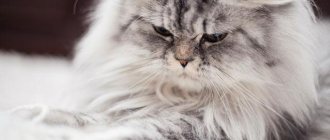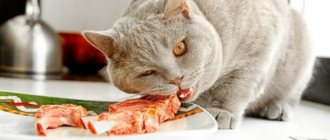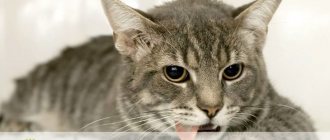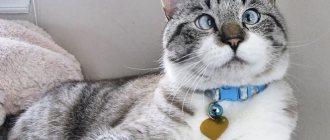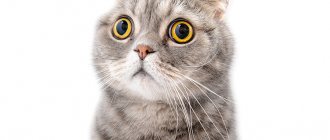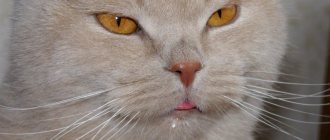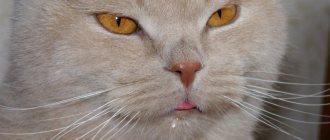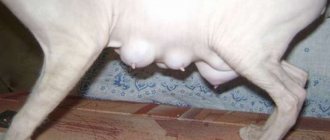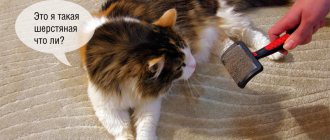Causes of Biliary Vomiting in Cats Diagnosis Treatment Biliary vomiting appears as yellow to green-orange vomit. When a cat vomits, it may make gurgling sounds and strain its abdomen. Sometimes the owner may not notice the cat is vomiting and finds puddles of yellow vomit, for example, upon arriving home from work. Since vomiting bile is not typical for a healthy animal, such signs in a pet cannot be ignored and you should contact a veterinarian.
In cats, the common bile duct and pancreatic duct open into the duodenum, which begins immediately after the stomach. The bile duct carries bile into the duodenum to aid in digestion, and the pancreatic duct carries pancreatic secretions.
Bile is a bitter, yellow-green secretion that is secreted by liver cells and stored in the gallbladder until needed. Participating in the digestion process, bile moves through the bile ducts into the duodenum. Normally, bile should not enter the stomach, since it will be prevented by the pyloric sphincter, which separates the stomach and the small intestine. Bile reflux will occur with reverse peristalsis of the duodenum and disruption of the pyloric sphincter. The gastric mucosa becomes highly irritated when bile enters and vomiting occurs as a reflex.
Cat's vomit is yellow
Almost all owners panic when their cats vomit yellow liquid. But you need to pull yourself together and observe how often this happens.
If yellow vomit occurs once and there are no other symptoms, a visit to the veterinarian is not required. However, if a cat vomits yellow liquid for several hours or days, he needs to be seen by a specialist immediately - this indicates the accumulation of too much bile in the stomach.
In a kitten, vomiting yellow liquid usually occurs in the presence of congenital pathologies of the digestive organs. This condition requires immediate medical attention. After all, the smaller the kitten, the higher the likelihood of its death due to dehydration. Babies older than 3 months have a higher survival rate in this situation.
Important! Bile can eat away at the stomach lining. Its prolonged accumulation in the stomach leads to the development of inflammation of the digestive organs and even the appearance of ulcers.
The mechanism of the gag reflex
Usually, owners believe that the cat vomited due to coughing. In fact, it is a symptom of vomiting, not a cause. The attack usually proceeds as follows:
- The cat appears to have increased salivation. She worries, constantly licks herself and swallows the saliva that forms.
- Then a cough begins, the animal breathes frequently and deeply, and stretches its head forward.
- The area of the pharynx and abdomen contracts, first fruitless vomiting appears, and then with the contents.
Important! For cats, vomiting every 3-4 days is normal.
Most often, cats vomit when they eat too quickly or eat too much. This often happens when feeding with low-quality industrial feed or with a mixed diet. Vomiting may also appear in the morning if the cat fell asleep hungry the day before.
If vomiting occurs from overeating, you just need to not let your pet eat or drink for 8 hours, and instead of water, offer to lick an ice cube. If a cat systematically vomits due to an incorrectly formulated diet, it needs to be reconsidered.
All long-haired cats also suffer from nausea and vomiting. When licked, the fur enters the stomach, where it gradually rolls into lumps, which cause irritation of the gastrointestinal tract. This is why burping fur should not be a concern. If there is blood, foam or mucus in the vomit, you should immediately contact the clinic.
Treatment of vomiting bile
Effective relief from attacks of bile vomiting depends entirely on successful treatment of the disease causing it.
Specialists at the Yauza Clinical Hospital will quickly identify the cause of the unpleasant symptom - vomiting bile. In a hospital setting, it is possible to carry out both conservative therapy and high-tech surgical treatment for most diseases that cause this unpleasant symptom.
You can see prices for services
Causes of yellow vomit in cats
The correct diagnosis largely depends on the reasons why the cat is vomiting yellow liquid. If the owner remembers when the cat vomited for the first time, and how often it happened in the future, this will help in diagnosis.
Reasons why a cat vomits bile:
- Foreign body in the stomach. Often, while playing, kittens accidentally swallow small objects. If the item eaten is very small, it will pass out with the feces without any problems. If it is quite large in size, the cat’s body will begin to actively produce bile to speed up the digestive process. As a result, the cat will begin to feel nauseated, and along with the vomit, it will regurgitate excess bile.
Important! Large objects eaten by a cat cannot be removed by its intestines, so the pet may well experience a blockage in the stomach or esophagus. If you accidentally swallow various objects, it is better to play it safe and take your cat to see a veterinarian.
- A sudden change in diet. Sometimes owners decide to switch their cat to a more nutritious and high-calorie food. If there is a sudden transition, he will vomit yellow liquid with the presence of remnants of undigested food. This is due to the fact that the liver's work slows down in such a situation, as it is not able to digest too much fatty food.
- Worm infestation. Helminthiasis is one of the most common causes of yellow liquid vomiting in cats. The body tries to rid itself of parasites, as in the case of a foreign body. Worms cause serious disturbances in the functioning of the digestive system. As a result, the cat vomits bile and does not eat anything.
Important! Heartworm infection can also be a reason why your cat is vomiting bile.
- Gallbladder diseases. With any abnormalities and pathologies in the functioning of the gallbladder, cats usually vomit yellow liquid with foam and a distinct odor of bile. Sometimes diarrhea mixed with bile and blood appears. In such a situation, you should immediately go to the veterinarian.
- Pregnancy. During pregnancy, all existing diseases in the cat will worsen. Some pregnant cats vomit yellow liquid. This indicates that they have problems with the gallbladder and its ducts.
- Infectious diseases. Vomiting of yellow liquid can be observed in cats with hepatitis, herpes, rhinotracheitis, panleukopenia (feline distemper). In addition to this symptom, weakness, watery diarrhea, and bad breath are observed. A pet can vomit not only after eating, but also on an empty stomach.
- Postoperative period. Sometimes cats may experience complications after various operations. Vomiting of yellow liquid mixed with blood, foam, brown or green mucus appears. The cat becomes inactive, and his health rapidly deteriorates. The animal's nose remains dry and warm, the fur loses its shine and begins to roll into lumps. In case of any postoperative complications, you must show your pet to a doctor who will select the necessary treatment for him.
Associated symptoms
Yellow vomiting in a cat may be accompanied by additional symptoms depending on the cause that led to its appearance:
- the presence of hairballs, food particles, foam in the vomit;
- refusal to eat;
- deterioration in wool quality;
- constipation.
If you are repeatedly vomiting yellow liquid, you should give your cat something to drink as often as possible. If he does not drink on his own, it is recommended to pour liquid into his mouth every half hour to prevent dehydration. There is no need to feed the cat during this period.
Important! It is strictly forbidden to give your cat antiemetic drugs without a doctor's prescription.
If your pet's condition does not improve within a day, you should take him to the veterinarian.
Treatment at home: if there is no veterinarian
The first thing to do is to lay your pet down so that its head hangs slightly. This is especially important with continuous vomiting to avoid swallowing the mass.
Of the medications, the most effective is Cerucal. However, it is not always available in the home medicine cabinet. An alternative option for Tserukal is No-shpa. The dosage is 0.1 mg per 1 kilogram of animal body weight.
If you know for sure that the cause of poor health is poisoning, then remedies such as Smecta, Atoxil or Enterosgel will help. An injection of Regidron solution helps with dehydration. Slightly salted drinking water also helps cope with water loss.
If the animal vomits, it is better to stop feeding for a while. But a bowl of fresh water is a must: prolonged regurgitation leads to dehydration.
Folk remedies that help to cope with poor health:
- Flaxseed decoction.
- Chamomile decoction.
When the acute symptoms pass, you can prepare food for your pet (for example, porridge) using chamomile infusion. The daily dosage of medicinal decoctions is from 1 to 3 tablespoons, depending on the cat’s body weight.
Vomiting in itself is not a disease. Rather, it is a reaction to various stimuli. Therefore, preventive measures concern the prevention of painful conditions that are accompanied by vomiting.
- Adjust your pet's diet. It is possible that the food is poorly digested. This applies to inexpensive dry food that irritates the digestive system.
- The cause of intestinal obstruction is an incorrect diet and a disorderly transition from one food to another. Long-term use of the same type of food is the key to preventing gastrointestinal diseases.
- If ready-made food is not suitable for your cat, switch it to natural food. Boiled chicken or rabbit meat, vegetables and cereals with water or chamomile infusion will quickly restore metabolic processes and normalize the animal’s condition.
- To prevent hair vomiting, use special food for long-haired breeds with special additives.
An important preventive measure is split meals. Feeding your pet small, frequent meals will help prevent “gluttony.”
When you need to see a doctor urgently
Sometimes a cat develops symptoms that signal that the animal requires immediate professional help:
- Frequent vomiting that lasts more than 5–10 hours. If your cat has vomited more than once and is constantly thirsty, she most likely has kidney problems.
- Temperature increase.
- Weakness and apathy.
- Very unpleasant smell of vomit and the same smell from the mouth.
- Diarrhea.
- Convulsions or fainting.
- Presence of blood or mucus in the vomit.
- Refusal of water and food. If your cat is vomiting but refuses to eat and loses weight, you may have lipidosis. With this pathology, too much fat accumulates in the liver area. As a result, the functioning of most organs is disrupted, and toxins accumulate in the body itself. A cat showing signs of lipidosis must be hospitalized as soon as possible, otherwise it will die.
- Fountain vomiting.
- Darkening of urine.
- Yellowness of the mucous membranes.
- Problems with passing urine. Sometimes, when vomiting and increased thirst, cats practically do not go to the toilet. This most often occurs when the animal's urinary tract is blocked by stones or worms. In such a situation, urgent surgical intervention will save the cat from death.
Diagnostic measures
In a veterinary clinic, if a yellow liquid is vomiting, the doctor will carefully examine the cat, palpate its stomach, check its mucous membranes and measure its body temperature. Next, he will need detailed information about the cat’s condition, as well as documents with notes on vaccination, deworming and previous diseases.
To make a correct diagnosis, the following manipulations are usually performed:
- X-ray of the intestines, liver, bladder;
- CT scan;
- Ultrasound of internal organs;
- endoscopy;
- biochemical and general blood test;
- analysis of stool, vomit and urine.
Owners should not refuse diagnostic measures, because they are all aimed at saving the cat’s life. Unfortunately, even modern diagnostic methods do not always make it possible to find out the causes of vomiting yellow liquid, so they often complement each other. For example, ultrasound and x-rays will not help determine poisoning, and also do not always show acute inflammatory processes in the gallbladder and liver. This is why doctors prescribe additional tests.
Survey
When a patient complains of vomiting bile, a set of laboratory and instrumental methods is required to assess the condition of the gastrointestinal tract. An examination prescribed by a gastroenterologist is aimed at determining the pathological condition that caused the release of bile-colored vomit. The most valuable diagnostic methods are:
- Endoscopic examination
. FGDS is used to visualize the esophagus, stomach, and upper parts of the duodenum. The method effectively detects inflammatory changes in organs, ulcerative-destructive processes and dysfunction of muscle sphincters. Additionally, a biopsy of pathologically altered tissue areas is performed for histological analysis. - X-ray methods
. Taking X-rays of the gastrointestinal tract with oral contrast is aimed at studying the structure of all parts of the digestive tract, detecting nonspecific signs of inflammatory processes and peptic ulcers. For a detailed study of the hepatobiliary system, percutaneous or retrograde cholangiopancreatography is performed. - Duodenal sounding
. A study of the functional activity of the gallbladder with an assessment of the microscopic properties of bile is often decisive for making the correct diagnosis; it is carried out in all patients with vomiting with impurities of bile acids. If an infectious etiology of the disease is suspected, bacteriological culture is recommended. - Ultrasonography
. Survey ultrasound of the abdominal organs is used as a non-invasive express method that reveals signs of pathology in a specific part of the gastrointestinal tract. In case of biliary diseases, a targeted ultrasound of the gallbladder is performed to study its morphological features and detect possible stones in the lumen of the organ. - Stool analysis
. The appearance of bilious vomiting is often accompanied by various changes in the coprogram. By studying the macroscopic and microscopic properties of feces, the quality of food digestion is assessed, and signs of possible pathology of the biliary system are detected. If the patient has a general infectious syndrome, a bacterial culture of stool is performed.
Laboratory methods are used to clarify the diagnosis: an analysis is often prescribed to determine the content of free and bound bilirubin in the blood, determine the concentration of amylase and lipase, and search for specific antibodies. After excluding organic causes of the symptom, if the disorder is possibly functional, studies of the autonomic nervous system and the patient’s mental state can be carried out.
Ultrasound of the gallbladder
